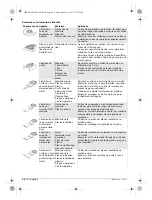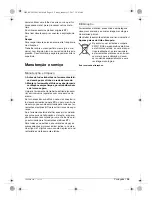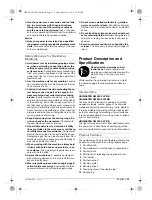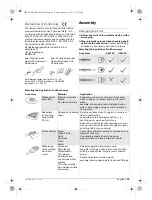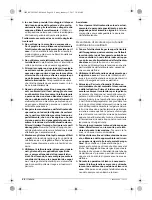
44
| English
1 609 92A 3E6 • 13.1.17
Sanding
The removal rate and the sanding pattern are pri-
marily determined by the choice of sanding sheet,
the preset oscillation rate and the applied pres-
sure.
Only flawless sanding sheets achieve good sand-
ing capacity and extend the service life of the ma-
chine.
Pay attention to apply uniform sanding pressure;
this increases the working life of the sanding
sheets.
Intensifiying the sanding pressure does not lead to
an increase of the sanding capacity, but to in-
creased wear of the machine and the sanding
sheet.
For precise on-the-spot sanding of edges, corners
and hard to reach areas, it is also possible to work
only with the tip or an edge of the sanding plate.
When selectively sanding on the spot, the sanding
sheet can heat up considerably. Reduce the orbital
stroke rate and the sanding pressure, and allow the
sanding sheet to cool down regularly.
A sanding sheet that has been used for metal
should not be used for other materials.
Use only original BTI sanding accessories.
For sanding, always connect the dust extraction.
Scraping
For scraping, select a high oscillation rate.
Work on a soft surface (e.g. wood) at a flat ange,
and apply only light pressure. Otherwise the scrap-
er can cut into the surface.
Maintenance and Service
Maintenance and Cleaning
Before any work on the machine itself, pull the
mains plug.
For safe and proper working, always keep the
machine and ventilation slots clean.
Clean Riff application tools (accessory) regularly
with a wire brush.
If the replacement of the supply cord is necessary,
this has to be done by BTI or an authorized BTI ser-
vice agent in order to avoid a safety hazard.
If the machine should fail despite the care taken in
manufacturing and testing procedures, repair
should be carried out by an after-sales service cen-
tre for BTI power tools.
In all correspondence and spare parts orders,
please always include the 7-digit order number giv-
en on the nameplate of the machine.
Disposal
The machine, accessories and packaging should
be sorted for environmental-friendly recycling.
Do not dispose of power tools into household
waste!
Only for EC countries:
According to the European Guideline
2012/19/EU for Waste Electrical
and Electronic Equipment and its
implementation into national right,
power tools that are no longer usable
must be collected separately and
disposed of in an environmentally
correct manner.
Subject to change without notice.
OBJ_BUCH-3003-001.book Page 44 Friday, January 13, 2017 10:03 AM

